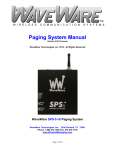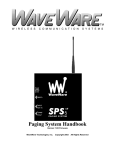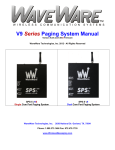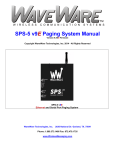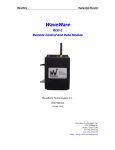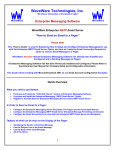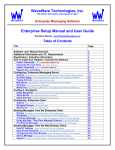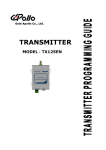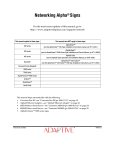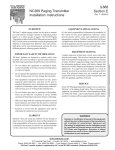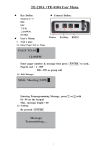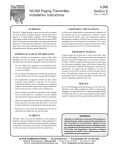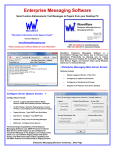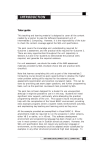Download WaveWare SPS-5 Specifications
Transcript
W I R E L E S S C O M M U N I C A T I O N S Y S T E M S SPS-5 Paging System Handbook Version 6.35 Firmware WaveWare Technologies, Inc. 2001 All Rights Reserved Introduction Your SPS-5tm Paging System allows you to send paging messages to one or more persons via pagers, and devices that incorporate POCSAG paging data receivers. You can setup automatic transmission of messages or you can compose messages on the fly and transmit them immediately. When you attach your paging system to a PC or other Host Device, plug in the provided serial cable and power adapter plug , and install and activate your paging software, you will be ready to make full use of the paging system. The SPS-5 Paging System can have a pager database programmed using the WaveWare Paging Encoder Setup Software, or you can immediately use the SPS-5 Paging System without programming. The SPS-5 paging system is synthesized and must be specified at time of purchase. Available as VHF model (148-174 MHz) or UHF model (440-470 MHz) Your SPS-5 Paging System, using V6.35 plus firmware, has the following capabilities: • Serial port controlled operation via RS-232 serial port, with DIP switch configurable communication parameters. Baud rates of 300, 1200, 2400, and 9600, with None, Even, and Odd parities. Default setting is 9600 N81. • 1 to 5 Watts effective radiated power with range depending upon terrain and obstructions. • The SPS-5 paging system is synthesized and must be specified at time of purchase. Available as VHF model (148-174 MHz) or UHF model (440-470 MHz). Default frequencies are 467.800 MHz and 464.600 MHz. • Industry standard POCSAG paging protocol covering the full range of paging functions, including: ⇒ 512, 1200 and 2400 bps RF data rates, auto-switching ⇒ tone/vibe only, numeric and alphanumeric paging message formats ⇒ multiple tone/vibration patterns • Support for multiple paging control protocols, including: ⇒ TAP v1.8 (variations also known as IXO and PET) ⇒ Extended TAP (TAP compatible extended interface supporting embedded control characters and paging message encoding parameters appended to the pager ID) ⇒ Simplex TAP, a single serial command string composed of a standard TAP message block. NOTE: Simplex TAP is the recommended interface protocol for system developers. ⇒ COMP1, delivery of <CR> or <CR><LF> delimited data to one or more pagers ⇒ COMP2, a command string composed of PagerID<CR>Message<CR> • Programmable Carrier Detect mode, which allows the automatic delay of transmission while a nearby transmitter of the same frequency is operating. Default is Carrier Detect On. • Programmable on-board pager database, supporting approximately 6,000 pagers. The pager database is not required for WaveWare protocol and Extended TAP protocol. Windows 95 software called WaveWare Paging Encoder Setup is provided for pager database programming, range testing, and general messaging. • Onboard watchdog timer to keep the paging system on-line at all times • Hardware or Software Flow Control, DIP switch selectable. Default is Hardware Flow Control • Verbose or Non-Verbose TAP Modes, DIP switch selectable. Default is Verbose TAP • Programmable transmitter duty cycle management On or Off. Default is Duty Cycle On • Remote administration of Pager Database. Pager database can be modified using specially formatted TAP paging messages. • Programmable Timer Triggered Messaging function, allowing the paging system to monitor the host system, and automatically deliver alert paging messages if the host system does not communicate to the paging system within a two minute time cycle. Operates concurrently with TAP mode only. • Programmable Contact Monitoring function, causing delivery of alert paging messages upon a Contact Close or Contact Open event, or both events. Operates concurrently with TAP mode only. 2 Obtaining Pagers for Your Paging System You can use a wide variety of paging receiver types with SPS-5 Paging Systems, including tone/vibe, numeric, alphanumeric, and wireless message centers. You can obtain WaveWare compatible paging receivers from many sources, including Motorola, NEC, Panasonic, and others. The paging receivers that you obtain for use with the SPS-5 Paging Systems should meet the following basic specifications: • Frequency - All paging receivers used with the SPS-5 Paging System must be of the same frequency and must match the frequency of the paging system transmitter. See the label on the WaveWare Transmitter Unit to identify the operating frequency of your paging system. • POCSAG - All paging receivers used with the SPS-5 Paging System must be POCSAG compatible. POCSAG is the paging protocol most frequently used in the paging industry. • Pager Type - You can mix different paging receiver types in a WaveWare installation. You can obtain the following paging receiver types for use with the SPS-5 Paging System: ⇒ Tone/vibe only, with or without multiple tone/vibrate cadence features. SPS-5 Paging Systems support pagers with multiple tone/vibrate features. WaveWare Tone/Vibe Pagers have two capcodes and have multiple tone/vibrate features. ⇒ Numeric ⇒ Alphanumeric ⇒ WaveWare Wireless Message Centers (allow group message notification on scrolling multicolor LED displays, using SPS-5 Paging Systems to communicate to the message centers) • Paging Data Rate - You can mix different paging data rates (baud rates) in a WaveWare installation. The data rate of the paging receivers can be your choice of 512, 1200, or 2400 bps (bits per second). • Capcodes - Each paging receiver used in an SPS-5 Paging System installation must have one or more capcodes (addresses) programmed into it. Each paging receiver used with a particular WaveWare installation, regardless of paging receiver type, must have a unique capcode programmed into it, in order to be able to transmit messages to that individual paging receiver. Contact your paging systems dealer for capcode assignment information. 3 Paging System Operation Your SPS-5 Paging System includes a either VHF or UHF transceiver, and onboard RS-232 communications, that transmits paging messages using the industry standard POCSAG paging protocol. The RS-232 communications allow you to interface the paging system to a PC or to other devices and systems that use RS-232 serial communications (Host Devices). Other models of SPS-5 Paging System products include encoder only models, and the combination of the paging encoder with VHF and UHF radio transceivers. The types of paging receivers that are compatible with your SPS-5 Paging System include: • Any POCSAG compatible paging receiver operating on the same frequency as the paging transmitter (in the UHF band) and operating at 512, 1200, or 2400 bps data rate. Pagers of this type include tone/vibe, numeric, and alphanumeric models and can be obtained from WaveWare Technologies, Motorola, NEC, Panasonic, Maxon, TEKK, and others. • WaveWare Wireless Message Centers, operating at the same frequency as your paging system. WaveWare Wireless Message Centers are normally configured to receive at a 2400 bps data rate. The paging system may be controlled by a PC, or other control system, that is running software designed to interface to the paging system. WaveWare wireless communication systems software is designed to take full advantage of the features of your SPS-5 Paging System. The TAP, COMP1, and COMP2 interface protocols are defined in this handbook to allow you or others to develop software or devices to directly control the transmitter. The paging system maintains an input buffer, which can receive commands from the Host Device while a page is being transmitted. When a command is received from the Host Device, the paging system responds with a message back to the Host Device. The paging system encodes the paging messages into POCSAG paging format and transmits the encoded paging message to the paging receivers of your choice. PC software developed to utilize the SPS-5 Paging System can be designed to maintain a simple database of pager ID numbers, or the software can be designed to allow definition of paging receiver attributes, including: • Pager Type ⇒ Tone/Vibe Only, with or without multiple tone/vibrate cadences ⇒ Numeric ⇒ Alphanumeric • Capcode - The unique address assigned to each paging receiver • RF Data Rate ⇒ 512 bps ⇒ 1200 bps ⇒ 2400 bps Refer to Appendix A – TAP Interface Specification for details on how to control the SPS-5 Paging System via the TAP protocol. Refer to Appendix H – COMP1 Interface Specification for details on how to control the SPS-5 Paging System via the COMP1 protocol. Refer to Appendix I – COMP2 Interface Specification for details on how to control the SPS-5 Paging System via the COMP2 protocol. Refer to Appendix J - Timer Triggered Messaging for details on how the Timer Triggered Messaging function operates. Refer to Appendix K - Contact Monitoring for details on how the Timer Triggered Messaging function operates. The Transmitter Unit may require the setting of an onboard DIP switch to change communication interface parameters. Refer to Appendix B – DIP Switch Settings for details on how to configure the DIP switches, as required. If you want to use the TAP interface protocol with 1 to 4 digit pager IDs, you will need to configure a pager database, using the WaveWare Paging Encoder Setup software. You can obtain the WaveWare Paging Encoder Setup software from the WaveWare web site, at http://www.wirelessmessaging.com 4 Paging System Installation Your SPS-5 Paging System includes a Black 8”x8”x2” Transmitter Unit, a “Rubber Duck” Antenna, a Mounting Kit, a 6’ Serial Cable, and a Power Adapter. Refer to the diagram on the following page. To install the paging system, perform the following steps: 1. Attach the “Rubber Duck” Antenna to the Transmitter Unit. In normal paging operations, the paging transmitter antenna should be oriented in a vertical position to maximize the paging range. Note: Do not attempt to operate the paging system without the antenna connected to the paging transmitter, as damage to the paging transmitter may occur. 2. Open the paging system enclosure, 2 screws 1 ea. top and bottom. Three screws are provided for the mounting of paging. Find suitable location for installation and mount. 3. Plug the Power Adapter Plug into the 2 conductor white power interface connector. 4. Plug the serial cable into the DB9 female connector on the Transmitter Unit. Tighten connector screws. 5. Plug the Power Adapter into a 110 VAC power outlet. The red colored PWR/BAT LED indicator on the Transmitter Unit should be illuminated when power is properly applied. 6. Program the pager database, if required, using WaveWare Paging Encoder Setup software, which is available from the WaveWare web site at http://www.wirelessmessaging.com 7. If you are using a PC as a Host Device, load paging control software, such as WaveWare software, on the PC and configure it to operate with your SPS-5 Paging System. Make sure the proper serial port settings are defined. The green colored TX LED indicator on the Transmitter Unit should illuminate during a paging transmission. If the Carrier Detect function is enabled, you may see the green colored CD LED indicator temporarily illuminate prior to some paging transmissions, if a carrier signal is detected from a nearby transmitter at the same frequency as your SPS-5 Paging System. 5 6 Trouble Shooting POWER When the WaveWare Paging Transmitter Unit is assembled and power is applied, you should be able to see a red PWR/BAT indicator illuminated on the Transmitter Unit. If not, verify that all connections are tight and verify that 110 VAC power is available at the power outlet. If connections are tight, power is available and the red PWR/BAT indicator doesn’t illuminate, determine if the Power Adapter is at fault by trying another Power Adapter. If the Transmitter Unit still does not respond, the Transmitter Unit is most likely in need of repair or replacement. At power-up, the Transmitter Unit is supposed to send a status message through the serial port to the host PC. PAGERS When you send a paging message command to the Transmitter unit from the PC, the green TX indicator on the Transmitter Unit should illuminate for a few seconds to indicate that transmission is occurring. If you don’t receive a message on the selected paging receiver, follow the checklist below to troubleshoot paging reception: 1. 2. 3. 4. 5. 6. 7. Pager turned on Pager has fresh battery Pager properly defined in the paging control application software on the host PC. Pager located at least arms length away from Transmitter Unit during transmission. (Some paging receivers do not properly decode paging messages when the paging receivers are located in close proximity to the transmitter antenna. Holding a paging receiver at arms length away from a transmitter antenna is usually sufficient to allow the paging receiver to properly decode a paging transmission). Antenna attached to Transmitter Unit Pager at the same frequency as the Paging System Pager uses POCSAG paging protocol CARRIER DETECT If the Carrier Detect mode is activated, and you find that paging transmissions are delayed for significant periods of time due to interference on the channel, you should temporarily inactivate the Carrier Detect mode to allow transmissions to occur regardless of other transmissions on the channel. You may find that you get excellent paging reception even with Carrier Detect inactivated. You may want to contact your nearest FCC field office to find out what is causing the unwanted interference on your channel. Please note that the typical SPS-5 Paging System installation uses a 2 watt system that operates subservient to other operators on the same frequency. If you find that the unwanted transmissions are legal, and if you find that your paging reception is suffering due to the unwanted transmissions from another source, you may have to change your paging system to another operating frequency. A frequency change is a costly process and should be avoided. If you have multiple SPS-5 Paging Systems installed in the same facility, and at the same operating frequency, you should activate the Carrier Detect mode on all paging systems in order to ensure paging messages are being properly transmitted to paging receivers. 7 SITE SURVEY Some installation sites might cause paging reception problems. It might be beneficial to perform a site survey by monitoring the radio waves in the area that you want to install a system. It also might be beneficial to perform a range test to find out of the installed signal will be strong enough to be received in all of the areas you want to cover. A site survey consists of both monitoring for radio signals on your channel, and verifying that the paging system has adequate power to cover the expected area. Following are some rules of thumb to use in deciding whether or not to perform a site survey. Perform a site survey if the facility or paging conditions meet one or more of the following criteria: 1) 2) 3) 4) 5) 6) 7) 8) Hospital or medical facility Unobstructed line of sight distance exceeding 1 1/2 miles Building above 5 stories Building greater than 50,000 square ft Multi-building facility Vicinity of seaports and shipyards Pager reception problems occur Excessive carrier signal detection conditions occur at the paging system You can monitor for radio signals using a simple multi-channel UHF band scanner, from sources like Radio Shack. You listen to the scanner for any audio output on that channel. The louder the audio, the stronger the signal. If the scanning results in excessive use of that radio channel, consider changing the paging system to operate on another radio channel. Use the scanner to identify the lowest traffic channels of those channels available to you. You may need to monitor for several minutes to determine which channels are busier than others. If pager reception problems occur, and there is not excessive foreign traffic on that channel, then consider boosting the strength of the paging signal. Typically, when you boost a signal, you will need to change the paging system equipment and pagers to a channel that allows higher power transmissions, measured in watts. 8 Appendix A – TAP Interface Specifications This appendix is included for those who want to develop their own paging control software or add an interface for the SPS-5 Paging System to their existing software applications.. A simple definition of the TAP protocol is that the TAP protocol normally requires a connect and disconnect process and normally assumes that the Host system maintains a database of pager reference numbers called IDs, and that the paging system maintains a database of all paging parameters associated with each ID. The TAP interface supports paging messages up to 244 characters in length. The actual maximum length of transmitted messages in the WaveWare TAP interface is 245 minus the ID field length. With an ID value of 5, you can transmit up to 245 characters per message. With an ID value of 1233425120, you can transmit up to 235 characters per message. The TAP specifications are maintained by PCIA (Personal Communications Industries Association). The formal TAP specification can be obtained via the Internet at http://www.pcia.com. To configure your SPS-5 Paging System to use the TAP paging protocol, you may be required to configure the DIP switch bank in the paging encoder. Please refer to Appendix B – DIP Switch Settings, for details on configuring communication protocols. As a quick reference, a typical DIP switch setting for the TAP interface is all 8 switches in the ON position, which tells the system to operate in TAP interface mode, with communication parameters of 9600N81, hardware flow control, and verbose responses from the encoder. Your SPS-5 Paging System typically communicates with a PC or other host device via RS-232 at 9600 Baud, 8 data bits and 1 stop bit. The eighth data bit is ignored (no parity). You can configure the paging system for other serial communication parameters. Please refer to Appendix B – DIP Switch Settings, for details on serial communication parameters. The paging encoder maintains an input buffer which can receive commands from the PC while a page is being transmitted. The input buffer should be able to contain approximately ten paging messages before getting full. When a command is received from the PC, the paging system responds with a message that includes error messages if the command was not understood or not properly transmitted. The first three digits of each paging system response conforms to the response codes defined in the TAP v1.8 specification. See Appendix D – TAP Response Codes for a listing of the response codes. The paging encoder encodes paging messages into POCSAG paging format and transmits the encoded paging message. If the Carrier Detect function is enabled, transmissions will be delayed while interfering signals are detected. Control characters recognized by the paging system in TAP protocol mode include: CARRIAGE RETURN <CR> $0D START OF TEXT <STX> $02 END OF TEXT <ETX> $03 END OF TRANSMISSION <EOT> $04 SUBSTITUTE <SUB> $1A ESCAPE <ESC> $1B Control characters generated by the SPS-5 Paging System in TAP protocol mode include: LINE FEED <LF> $0A CARRIAGE RETURN <CR> $0D ACKNOWLEDGE <ACK> $06 NEGATIVE ACKNOWLEDGE <NAK> $15 ABANDON TRANSACTION <RS> $1E ESCAPE <ESC> $1B END OF TRANSMISSION <EOT> $04 XON <XON> $13 XOFF <XOFF> $11 Appendix A – TAP Interface Specifications - 9 The TAP mo de of operation can be supplemented with two additional functions, including Host Monitoring Function, and Contact Monitoring Function. See Appendix J - Host Monitoring Function and Appendix K - Contact Monitoring Function, for operational details. The operational modes available for paging using the TAP Paging Protocol include: • • • • System Identification Command Paging Session Login Paging Operation Paging Session Logout SYSTEM IDENTIFICATION COMMAND The System Identification command allows installation programs and other software applications to poll serial ports for the existence of a WaveWare paging encoder using the standard ATI command. This can be used for a supervised process (also called keep-alive) where the host system periodically polls the paging system for a response. When the WaveWare paging transmitter recognizes a command formatted as ATI<CR>, the transmitter responds with the following message: WaveWare Paging Encoder v6.35<CR> The firmware version number is subject to change. PAGING SESSION LOGIN The Paging Session Login mode allows a Host Device, sometimes called a Remote Entry Device, to initiate communications with the paging system. With the SPS-5 Paging System, the Login process is optional. The SPS-5 Paging System will automatically login a Host Device and process the paging message if it recognizes a properly formatted TAP message block at any point in it’s operation. The Host Device initiates the Login process by transmitting a carriage return <CR> character every two seconds until the paging system properly responds or until the Host Device times out and notifies the operator of a bad connection. The paging system will respond with “ID=<CR>” (Note: the quotation characters are used here only for reference and are not included in the transactions). The “ID=<CR>” will not be repeated or timed out by the paging system. The Host Device should respond to the paging system with: <ESC>PG1<CR> or <ESC>pg1<CR> The SPS-5 Paging System will then respond with: 110 1.8<CR>WaveWare Paging Encoder v6.35<CR><ACK><CR> The “110 1.8” message indicates that the system conforms to TAP specification version 1.8 and should be backward compatible with earlier TAP implementations. The paging system then notifies the Host Device that it is ready to accept messages as follows: <ESC>[p<CR> This completes the Login process. Appendix A – TAP Interface Specifications - 10 PAGING OPERATION Paging transactions are transmitted in blocks of characters, where one transaction is sent per block. Each block sent by the Host Device is acknowledged by the paging system. The Host Device must wait for this acknowledgement before sending the next block. The SPS-5 Paging System provides acknowledgement in the form of an <ACK> character. The SPS-5 Paging System supports TAP message blocks up to 253 characters in length, with a 235 to 244 character message, from 1 to 10 characters for ID (pager number), plus 5 control characters, and a 3 character checksum. (Message field length is restricted as follows: when a 1 character ID is used, a 244 character message can be accommo dated, and so on, for a total of 253 characters, such that when a 4 character ID is used, a 241 character message can be accommodated. The maximum ID field length of 10 causes a maximum message field length of 235 characters). A block always carries two fields with their associated carriage returns. The message field may be empty, but it’s carriage return must be included in the data block. The TAP message block format is as follows: <STX>ID<CR>Message<CR><ETX>Checksum<CR> The ID field is a one to ten character pager number. Leading zeroes are not required. The Message field accommodates up to 235 alphanumeric characters. The Checksum field provides a checksum for the previous portion of the TAP message block. See Appendix D – TAP Checksum Calculation, for sample code to create the checksum field. The Message field can be formatted as follows: • For alphanumeric paging messages, all 7-bit ASCII “non-control” characters are valid except ^, ~, and _ (underscore) • For numeric paging messages, valid characters are the numbers 0 through 9, - (hyphen), and space • Control characters can be embedded into paging messages so that high end alpha pagers and paging data receivers can respond with formatted screen displays and with formatted serial output, as required. Control characters (typically <CR> and <LF>) can be embedded in messages by using the Transparency Option. The Transparency Option replaces a non-printable control character with the SUB (Hex 1A) character immediately followed by the control code offset by 40 Hex. See Appendix G Embedded Control Characters for details on how to embed control characters in paging messages. The WaveWare TAP interface supports ID field lengths from 1 to 10 digits. The ID field can be formatted using two different methods, as follows: • Method 1 - ID field lengths from 1 to 4 digits will cause a pager database lookup. ID fields of this format must contain numeric digits only. The numeric ID value will be compared to the ID values stored in the SPS-5 Paging System’s onboard pager database. • Method 2 - ID field lengths from 5 to 10 digits will cause Extended ID processing. Extended ID processing assumes that the last 3 digits of the ID field define paging message encoding attributes, while the preceding digits define the pager capcode. Extended ID processing allows you to avoid the process of configuring a pager database in the SPS-5 Paging System. See Appendix E – Extended ID Processing for details on how to format the ID field. When the Host Device delivers a TAP Message Block to the SPS-5 Paging System, if the message block is properly formatted, and a 1 to 4 digit ID field matches the pager database, the paging system will respond with an initial response code as follows: 211 Page(s) Sent Successfully<CR> Appendix A – TAP Interface Specifications - 11 If your SPS-5 Paging System is configured to operate using TAP Non-Verbose mode, the paging system will respond only with an initial response code of: 211<CR> Following the first part of the TAP message block response, if the input buffer of the paging system has capacity for another TAP message block, the paging system will send the following message. <ACK><CR> The <ACK><CR> response can be used as a flow control method to prevent overflow and lost messages. As alternative flow control methods, you can use either hardware or software flow control. If the paging system DIP switch is set to hardware flow control mode, the RS-232 CTS signal will be deasserted when the input buffer doesn’t have capacity for another TAP message block, and reasserted when capacity exists in the input buffer. If the DIP switch is set to software flow control mode, an XOFF character (0x11) will be output in the response string to indicate the the input buffer doesn't have capacity for another TAP message block. When capacity is available, an XON character (0x13) will be output. When the Host Device delivers a TAP Message Block and a checksum error occurs, the paging system will respond with an error message and a <NAK><CR>, which tells the Host Device to resend the transaction. See Appendix E – TAP Response Codes for more information on paging system response messages. If the TAP Message Block checksum is OK, but the Message Block violates formatting rules, the paging system will respond with an error message and an <RS><CR>, which tells the Host Device to abandon the transaction. An example error message sequence follows: 514 Checksum Error – Exp. 2:9 Got 2:X<CR> <NAK><CR> PAGING SESSION LOGOUT The Paging Session Logout mode allows a Host Device, sometimes called a Remote Entry Device, to stop communications with the paging system. With the SPS-5 Paging System, the Logout process is optional. The SPS-5 Paging System will automatically login a Host Device and process the paging message if it recognizes a properly formatted TAP message block at any point in it’s operation. To initiate a logout (disconnect sequence) the Host Device should send the following to the paging system: <EOT><CR> Upon recognizing a logout command, the paging system will respond with: PAGING EXCHANGE DISCONNECT<CR><ESC><EOT><CR> Appendix A – TAP Interface Specifications - 12 Appendix B – DIP Switch Settings You may be required to configure the DIP switch bank in the paging encoder to establish the appropriate operating mode and serial communication parameters. Your SPS-5 Paging System typically communicates with a PC or other host system via RS-232 at 9600 Baud, 8 data bits and 1 stop bit. You can configure the paging system for other serial communication parameters. The available operating modes include TAP Verbose, TAP Non-Verbose, COMP1, and COMP2. TAP Verbose means that the paging system will include human readable messages after each paging request is received. TAP Non-Verbose reduces the paging system human readable response to 3 digit numeric codes. The Non-Verbose mode is useful in situations where you want to minimize the serial data throughput requirements, which tends to allow paging messages to be delivered more quickly. Refer to Appendix A for a definition of the TAP protocol. COMP1 means that any data received on the serial port will be sent to all pagers in the pager database. Refer to Appendix H for a definition of the COMP1 protocol. COMP2 means that data formatted as PagerID<CR>Message<CR> will cause the Message to be delivered to the specified PagerID. Refer to Appendix I for a definition of the COMP2 protocol. Independent of operating modes, you can configure the serial port baud and parity, and you can configure whether hardware or software flow control is used. DIP Switch Settings 1 2 3 4 5 6 Flow Ctrl Baud (Serial Interface) Parity (Serial Interface) Protocol 1 = H/W 0 = S/W 11 = 9600 10 = 2400 01 = 1200 00 = 300 11 = None (N81) 10 = None (N81) 01 = Even (E71) 00 = Odd 111 = TAP Verbose 110 = TAP Non-Verbose 101 = COMP1 100 = TAP Verbose 011 = TAP Verbose 010 = TAP Non-Verbose 001 = COMP2 000 = TAP Verbose Appendix B – DIP Switch Settings - 13 7 8 ON = 1 Appendix C – TAP Checksum Calculation Following is sample Visual Basic™ code that creates a string to be sent to the paging system. A subset of the string has a checksum calculation performed on it, then the checksum and a control character are appended to form the string to be sent to the paging system. Refer to the TAP specification at http://www.pcia.com, for more details on the checksum calculation. 'String that checksum is calculated on, of the form: ‘<STX>ID<CR>Message<CR><ETX> TXString$ = Chr(2) & txtID.Text & Chr(13) & txtMessage.Text & Chr(13) & Chr(3) 'Calculate and append checksum j=1 Sum = 0 Do Until j > Len(TXString$) B$ = Mid(TXString$, j, 1) D = Asc(B$) Sum = Sum + D j=j+1 Loop 'Create the three characters to be transmitted to represent this checksum. d3 = 48 + Sum - Int(Sum / 16) * 16 Sum = Int(Sum / 16) d2 = 48 + Sum - Int(Sum / 16) * 16 Sum = Int(Sum / 16) d1 = 48 + Sum - Int(Sum / 16) * 16 Check1$ = Chr$(d1) Check2$ = Chr$(d2) Check3$ = Chr$(d3) CheckSum$ = Check1$ & Check2$ & Check3$ 'Create complete string to be sent to paging system, of the form: ‘<STX>ID<CR>Message<CR><ETX>Checksum<CR> TXString$ = TXString$ & CheckSum$ & Chr(13) Appendix C – TAP Checksum Calculation - 14 Appendix D – TAP Response Codes Following is a table of response codes supported by the SPS-5 Paging System. Refer to the TAP specification at http://www.pcia.com, for more details on the Response Codes. Please note that a <NAK> response means the message should be resent by the host, and an <RS> response means the message should be abandoned by the host. Response Code Definition 110 1.8 Paging system supports TAP Specification v1.8 211 Page(s) Sent Successfully Paging message(s) successfully delivered. This message is accompanied by an <ACK> 510 Invalid character in pager ID Pager ID field contains illegal characters. This message is accompanied by an <RS> 511 Invalid pager ID - not in database Pager ID was legal and 1 to 4 characters in length, but didn’t match database lookup. This message is accompanied by an <RS> 512 Temporarily cannot deliver. Queue full. Try later Paging System input buffer is full. This message is accompanied by a <NAK> 514 Checksum Error. Exp XXX; Got: YYY Checksum didn’t match message block. This message is accompanied by a <NAK> Appendix D – TAP Response Codes - 15 Appendix E – Extended ID Processing The WaveWare TAP interface and the COMP2 interface support ID field lengths from 1 to 10 digits. The ID field can be formatted as follows: • Standard Method - ID field lengths from 1 to 4 digits will cause a pager database lookup. ID fields of this format must contain numeric digits only. The numeric ID value will be compared to the ID values stored in the SPS-5 Paging System’s onboard pager database. • Extended ID Method - ID field lengths from 5 to 10 digits will cause Extended ID processing. Extended ID processing assumes that the last 3 digits of the ID field define paging message encoding attributes, while the preceding digits define the pager capcode. Extended ID processing allows you to avoid the process of configuring a pager database in the SPS-5 Paging System Extended ID fields should be of the form: CCCCCCCERF, where C represents the capcode, E represents Message Encoding Type, R represents RF data rate, and F represents Function Code. The Extended ID field can be represented in either numeric or alphanumeric format. All Extended ID fields must be between 5 and 10 digits in length to cause the paging system to perform Extended ID processing. Incorrect formatting of extended ID fields causes a <NAK> response combined with an explanation message. CCCCCCC is a 2 to 7 digit numeric value representing a pager capcode. Leading zeroes are optional except in the case of capcodes 8 and 9, which should be represented with at least one leading zero, e.g. 08 or 09. E is the message encoding type, where “0” (zero), “n”, or “N” represent “numeric encoding”, and “1”, “a”, or “A” represent “alphanumeric encoding”. The numeric values for E are provided to support numeric-only ID fields in paging control software. R is the RF data rate, where “5” represents 512 bps, “1” represents 1200 bps, and “2” represents 2400 bps. F defines the function code to be delivered, where “1” is function code 1, “2” is function code 2, “3” is function code 3, and “4” is function code 4. A function code of “0” is also valid. A function code of “0” causes the default function code for a particular Message Encoding Type (“E”) to be substituted. The default value for F is “4” when the E value is “alphanumeric encoding”, and “1” when the E value is “numeric encoding”. Following are valid example Extended ID fields causing Extended ID processing: 08A20 – Causes delivery of a standard (function code 4) alphanumeric message to capcode 0000008 at 2400 bps 08A24 – Same result as above 0008124 – Same result as above 0000008124 – Same result as above 11A53 – Causes delivery of an alphanumeric message with function code 3 to capcode 0000011 at 512 bps 0000011A53 – Same result as above 11N53 – Same result as above, but with numeric encoding 038N52 – Causes delivery of a numeric message with function code 2 to capcode 0000038 at 512 bps Appendix F – Embedded Control Characters - 16 Appendix F – Embedded Control Characters To embed a control character in a paging message, include a <SUB> control character followed by an offset version of the control character you want to embed. You offset the control character by adding 40 HEX to the control character, to make the character printable. Adding 40 HEX to Carriage Return gives you M. Adding 40 HEX to Line Feed gives you J. The character combination of <SUB>M causes a Carriage Return control character to be embedded in the encoded paging message, while <SUB>J causes a Line Feed control character to be embedded. The <SUB> character needs to be passed to the SPS-5 Paging System as a HEX character. In the WaveWare Paging Encoder Setup software, you can embed a Carriage Return by entering <CR> in the message body, and embed a Line Feed character by entering <LF> in the message body. In the Microsoft Visual Basic programming language, you can use the following code example to define the embedded control character string to be delivered through the serial port to the paging system. In this example, we are embedding only the Carriage Return control character: DIM CarriageReturnString As String, DIM MessageLine1 As String DIM MessageLine2 As String DIM TXString As String CarriageReturnString = Chr(26) & "M" LineFeedString = Chr(26) & "J" MessageLine1 = "Line 1 of test message" MessageLine2 = "Line 2 of test message" TXString = MessageLine1 & CarriageReturnString & MessageLine2 form1.MSComm1.Output = TXString Appendix F – Embedded Control Characters - 17 Appendix G – COMP1 Interface Specifications This appendix is included for those who want to attach the SPS-5 Paging System to existing systems that output raw data or simple data strings that are normally used in printing status logs on serial printers. The COMP1 protocol is designed to emulate one of the operational modes of the Motorola People Finder™ paging system. A simple definition of the COMP1 protocol is that the COMP1 protocol allows raw ASCII data to be sent to all pagers in the SPS-5 Paging System's pager database. The COMP1 interface supports paging messages up to 255 characters in length. To configure your SPS-5 Paging System to use the COMP1 paging protocol, you may be required to configure the DIP switch bank in the paging encoder. Please refer to Appendix B – DIP Switch Settings, for details on configuring communication protocols. As a quick reference, the DIP switch setting for the COMP1 interface is switch 7 in the OFF position and all other switches in the ON position. This tells the system to operate in COMP1 interface mode, with communication parameters of 9600N81, with hardware flow control. Your SPS-5 Paging System typically communicates with a PC or other host device via RS-232 at 9600 Baud, 8 data bits and 1 stop bit. The eighth data bit is ignored (no parity). You can configure the paging system for other serial communication parameters. Please refer to Appendix B – DIP Switch Settings, for details on serial communication parameters. The paging system maintains an input buffer, which can receive commands from the PC while paging messages are being transmitted. The paging encoder encodes paging messages into POCSAG paging format and transmits the encoded paging message through the internal radio transmitter. If the Carrier Detect function is enabled, transmissions will be delayed while interfering signals are detected. Control characters recognized by the paging encoder in COMP1 protocol mode include: CARRIAGE RETURN <CR> $0D LINEFEED <LF> $0A Control characters generated by the SPS-5 Paging System in COMP1 protocol mode when software flow control mode is active include: XON <XON> $13 XOFF <XOFF> $11 In COMP1 interface protocol, the SPS-5 Paging System does not provide feedback response signals on the serial port, other than flow control signals. COMP1 is a one way (simplex) protocol. The COMP1 operation is as follows: When incoming data is detected on the serial port, one of three things will happen: 1) A carriage return character is detected in the datastream, 2) a time period of approximately 10 seconds elapses after receipt of the last character on the serial port, or 3) 256 characters or more accumulate in the serial port input buffer. If any of these three events occur, the paging system will strip any carriage return and linefeed characters and transmit the remainder of the datastream to all pagers defined in the encoder's pager database. If the serial port input buffer becomes filled with greater than 600 characters, the paging system will output either a hardware or software flow control response, depending upon how DIP switch 1 is configured. Once the serial port input buffer drops below 450 characters, the paging system will use flow control signals to indicate that it is no longer busy and that additional data can be delivered to the serial port. Appendix G – COMP1 Interface Specifications - 18 NOTE: When using COMP1 mode, please note that all data is transmitted to all pagers in the SPS-5 Paging System pager database. When setting up for COMP1 operation, you should limit the pager quantity in the pager database to no more than a few pagers, in order to avoid excessive paging transmissions. Appendix G – COMP1 Interface Specifications - 19 Appendix H – COMP2 Interface Specifications This appendix is included for those who want to attach the SPS-5 Paging System to existing systems that output simplified paging system control commands. The COMP2 protocol is designed to emulate one of the operational modes of the Motorola People Finder™ paging system. A simple definition of the COMP2 protocol is that the COMP2 protocol allows a message formatted as PagerID<CR>Message<CR> to cause the Message to be delivered to the associated PagerID defined in the SPS-5 Paging System's pager database. The COMP2 interface supports paging messages up to 253 characters in length. The total length of the control string, including <CR> and <LF> characters, cannot exceed 256 characters. The PagerID field can be from 1 to 10 characters in length. PagerID field lengths from 5 to 10 digits are assumed to be Extended Pager IDs (See Appendix E – Extended Pager ID Processing). To configure your SPS-5 Paging System to use the COMP2 paging protocol, you may be required to configure the DIP switch bank in the paging encoder. Please refer to Appendix B – DIP Switch Settings, for details on configuring communication protocols. As a quick reference, the DIP switch setting for the COMP1 interface is switches 6 and 7 in the OFF position and all other switches in the ON position. This tells the system to operate in COMP2 interface mode, with communication parameters of 9600N81, with hardware flow control. Your SPS-5 Paging System typically communicates with a PC or other host device via RS-232 at 9600 Baud, 8 data bits and 1 stop bit. The eighth data bit is ignored (no parity). You can configure the paging system for other serial communication parameters. Please refer to Appendix B – DIP Switch Settings, for details on serial communication parameters. The paging system maintains an input buffer, which can receive commands from the PC while paging messages are being transmitted. The paging encoder encodes paging messages into POCSAG paging format and transmits the encoded paging message through the internal radio transmitter. If the Carrier Detect function is enabled, transmissions will be delayed while interfering signals are detected. Control characters recognized by the paging encoder in COMP2 protocol mode include: CARRIAGE RETURN <CR> $0D LINEFEED <LF> $0A DELETE <DEL> $7F or $FF Control characters generated by the SPS-5 Paging System in COMP2 protocol mode when software flow control mode is active include: CARRIAGE RETURN <CR> $0D XON <XON> $13 XOFF <XOFF> $11 ABANDON TRANSACTION <RS> $1E In COMP2 interface protocol, the SPS-5 Paging System does not provide feedback response signals on the serial port, other than flow control signals. COMP2 can operate as either a one way (simplex) protocol or a two way (duplex) protocol. The COMP2 operation is as follows: The SPS-5 Paging System in COMP2 mode is controlled using control strings formatted as follows: Single Message Example: PagerID<CR>Message<CR> Tone/Vibe Only Example: PagerID<CR><CR> Multiple Message Example: Appendix H – COMP2 Interface Specifications - 20 PagerID1<CR>Message1<CR>PagerID2<CR>Message2<CR> Forced Resynchronization Example: <DEL><DEL><DEL>PagerID<CR>Message<CR> When incoming data is detected on the serial port, one of three things will happen: 1) The data in the serial port input buffer contains properly formatted COMP2 command strings, 2) a time period of approximately 10 seconds elapses after receipt of the last character on the serial port, or 3) 256 characters or more accumulate in the serial port input buffer. The serial port data is analyzed character by character to see if a properly formatted command string exists. If the serial port data contains one or more properly formatted COMP2 command strings, then the paging message(s) will be transmitted to the specified pager ID(s) as long as those pager ID(s) exist in the SPS-5 Paging System's pager database. If a pager ID doesn't exist in the pager database, an error message will be output by the paging system as follows: Invalid character in pager ID<CR><CR><RS><CR> Any portions of the serial port input buffer that don't meet the COMP2 message formatting requirements are discarded. The original COMP2 protocol has an inherent weakness of using the <CR> character to delimit both the Pager ID field and the Message field. This approach allows the possibility of an extra or missing <CR> character to cause the host system and the paging system to get out of synch with each other, causing multiple paging messages to be rejected by the paging system. A more robust version of the COMP2 protocol uses three <DEL> characters as indicators of the beginning of a COMP2 command string. The use of three <DEL> characters at the beginning of each output message assures that out-of-synch conditions will not occur. The forced resynchronization method is optional. As additional synchronization insurance, the WaveWare COMP2 implementation has been designed to stay in synch even if one or more <CR> characters immediately precede a properly formatted COMP2 command string. If the 10 second timeout occurs while waiting for all of the characters required for a properly formatted COMP2 message to arrive on the serial port, the data in the serial port input buffer will be discarded. If 256 or more characters arrive in the paging system's serial port input buffer, and the first 256 characters contain all of the elements of a properly formatted COMP2 command string except for the trailing <CR> character, then the <CR> will be assumed and only the first 256 characters of the input buffer will be processed as a valid COMP2 paging message. If the serial port input buffer becomes filled with greater than 600 characters, the paging system will output either a hardware or software flow control response, depending upon how DIP switch 1 is configured. Once the serial port input buffer drops below 450 characters, the paging system will use flow control signals to indicate that it is no longer busy and that additional data can be delivered to the serial port. Appendix H – COMP2 Interface Specifications - 21 Appendix I – Host Monitoring Function The Host Monitoring Function is designed to allow the SPS-5 Paging System to be used for purposes of automatically transmitting predefined messages upon timer related conditions. The Host Monitoring Function can be activated during the process of programming the pager database using the WaveWare Paging Encoder Setup software. The Host Monitoring Function is available only with the TAP mode of operation. The Host Monitoring Function operates as follows: Concurrent with the encoder monitoring the serial port for normal TAP messages, the Host Monitoring Function uses an internal two minute timer cycle to determine whether or not to transmit predefined messages. If the two minute timer is not reset by the host system while the Host Monitoring Function is active, the paging system will transmit predefined messages as defined in the pager database configuration. The two minute timer is reset under the following conditions: • Reception of a valid TAP protocol formatted control string on the serial port • Reception of the ATI<CR> control string on the serial port • Timeout of the two minute timer When programming the SPS-5 Paging System pager database, each of the six sequentially defined groups of pagers in the pager database can be associated with the Host Monitoring Function and one of two configurable predefined messages of up to 14 characters each. If a pager group has the Host Monitoring Function active, all pagers in that pager group will receive a predefined message. Some practical applications of the Host Monitoring Function are as follows: • In mission critical environments, the Host Monitoring Function can be used to monitor the host system and notify someone's pager that the host system needs attention. To accomplish this, program the host control software to output a TAP message or the ATI<CR> command every minute. If the host gets disconnected from the paging system or the host stops functioning, the Host Monitoring Function will come into play. • Use the Host Monitoring Function in a supervisory controlled paging system environment to allow other portions of the system to know that the paging system's encoder and transceiver are functioning properly, by monitoring for the predefined message being transmitted automatically by the paging system. Appendix I – Host Monitoring Function - 22 Appendix J – Contact Monitoring Function The Contact Monitoring Function is designed to allow the SPS-5 Paging System to be used for purposes of automatically transmitting predefined messages upon contact closure and/or contact open conditions. The Contact Monitoring Function can be activated during the process of programming the pager database using the WaveWare Paging Encoder Setup software. The Contact Monitoring Function is available only with the TAP mode of operation. An alarm pushbutton option is available on the SPS-5 paging system, which allows you to press a momentary pushbutton on the front of the SPS-5 enclosure to perform alert paging in addition to performing TAP protocol serial port interface operations. The Contact Monitoring Function operates as follows: Concurrent with the paging encoder monitoring the serial port for normal TAP messages, the Contact Monitoring Function monitors the RTS serial port signal on the paging encoder serial port for voltage changes. A contact closure event occurs when the RTS line swings to a negative voltage, and a contact open event occurs when the RTS line swings to a positive or zero voltage. The RTS line on the paging encoder 9 pin serial port connector is Pin 7. When programming the SPS-5 Paging System pager database, each of the six sequentially defined groups of pagers in the pager database can be associated with the Contact Monitoring Function and one of two configurable predefined messages of up to 14 characters each. If a pager group has the Contact Monitoring Function active, all pagers in that pager group will receive a predefined message. Some practical applications of the Contact Monitoring Function are as follows: • In mission critical environments, the Contact Monitoring Function can be used to monitor the host system and notify someone's pager that the host system needs attention. To accomplish this, wire up Pin 7 of the paging encoder's 9 pin serial port to a serial port pin on the host system. The host system serial port pin must change voltage when the host system is powered up or active. If the host system gets disconnected from the paging system or the host system loses power or stops functioning, the Contact Monitoring Function will come into play. • Use a mechanical switch or other form of contact closure or contact opening to cause paging to occur. To accomplish this, wire up Pin 7 of the paging encoder's 9 pin serial port to one side of the switch, and wire Pin 8 (CTS) of the paging encoder's 9 pin serial port to the other side of the switch. Upon closure or opening, the voltage provided by the CTS signal on the paging encoder's serial port will provide the signal necessary to trigger the Contact Monitoring Function's paging output. Appendix J – Contact Monitoring Function - 23























